Western Sydney University 401021 Nursing Case Study: Patient A
VerifiedAdded on 2022/09/14
|7
|1889
|17
Case Study
AI Summary
This case study examines the tragic incident of Patient A, an 81-year-old admitted to the hospital with breathlessness, who unfortunately passed away due to septicaemia. The assignment analyzes the case, highlighting the negligence of healthcare professionals, including the GP, VMO, and nurses, in providing adequate care. The study identifies contributory factors such as incorrect diagnoses, delayed treatment, and medication errors. It also explores the implications for future practice, emphasizing the importance of ethical practices, duty of care, patient-centered approaches, and clear communication. The analysis underscores the need for healthcare professionals to prioritize patient safety, anticipate risks, and adhere to professional standards to prevent similar incidents. The study also discusses the potential for legal action against healthcare providers for medical negligence and the importance of a patient-centered approach to healthcare.
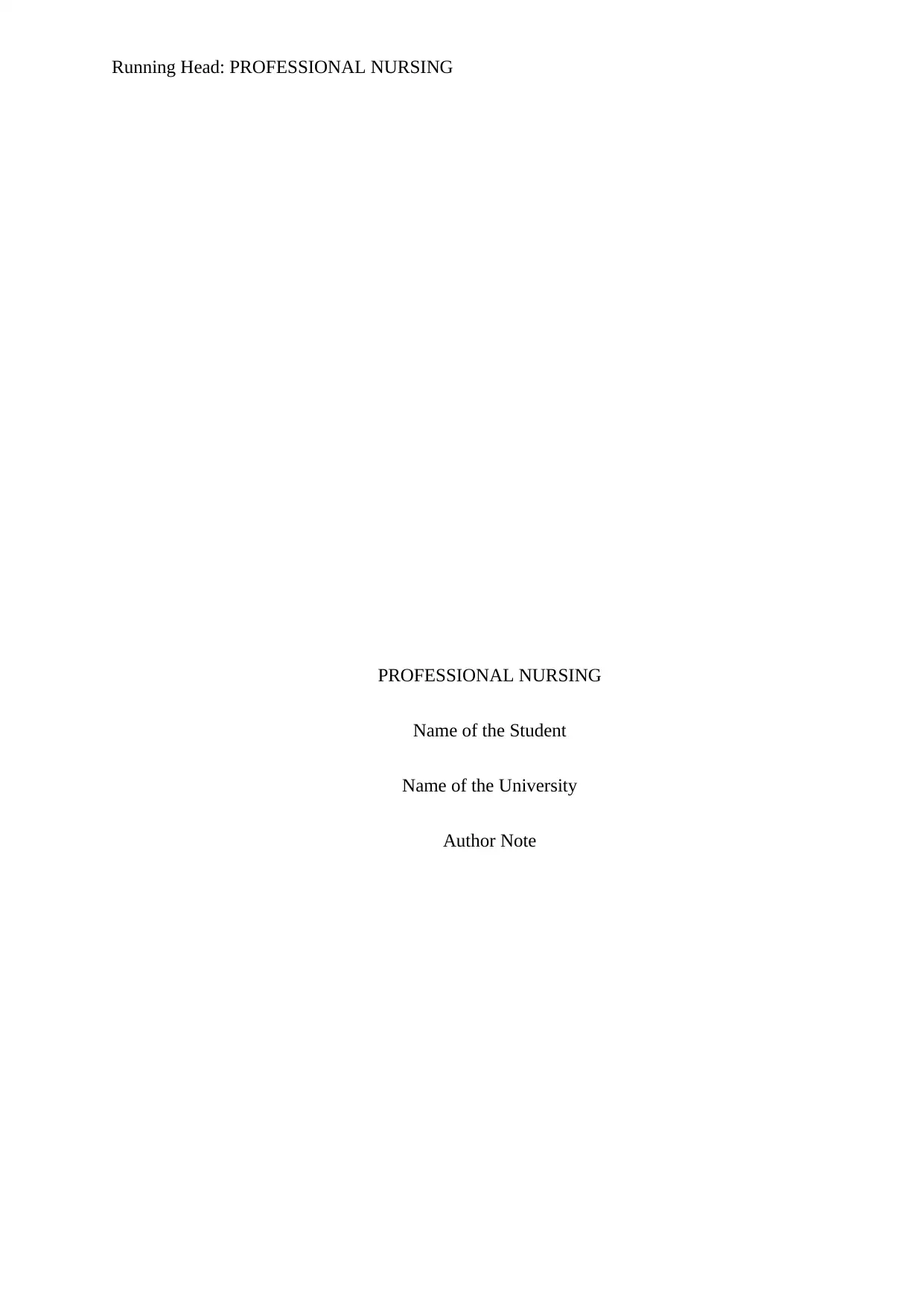
Running Head: PROFESSIONAL NURSING
PROFESSIONAL NURSING
Name of the Student
Name of the University
Author Note
PROFESSIONAL NURSING
Name of the Student
Name of the University
Author Note
Paraphrase This Document
Need a fresh take? Get an instant paraphrase of this document with our AI Paraphraser
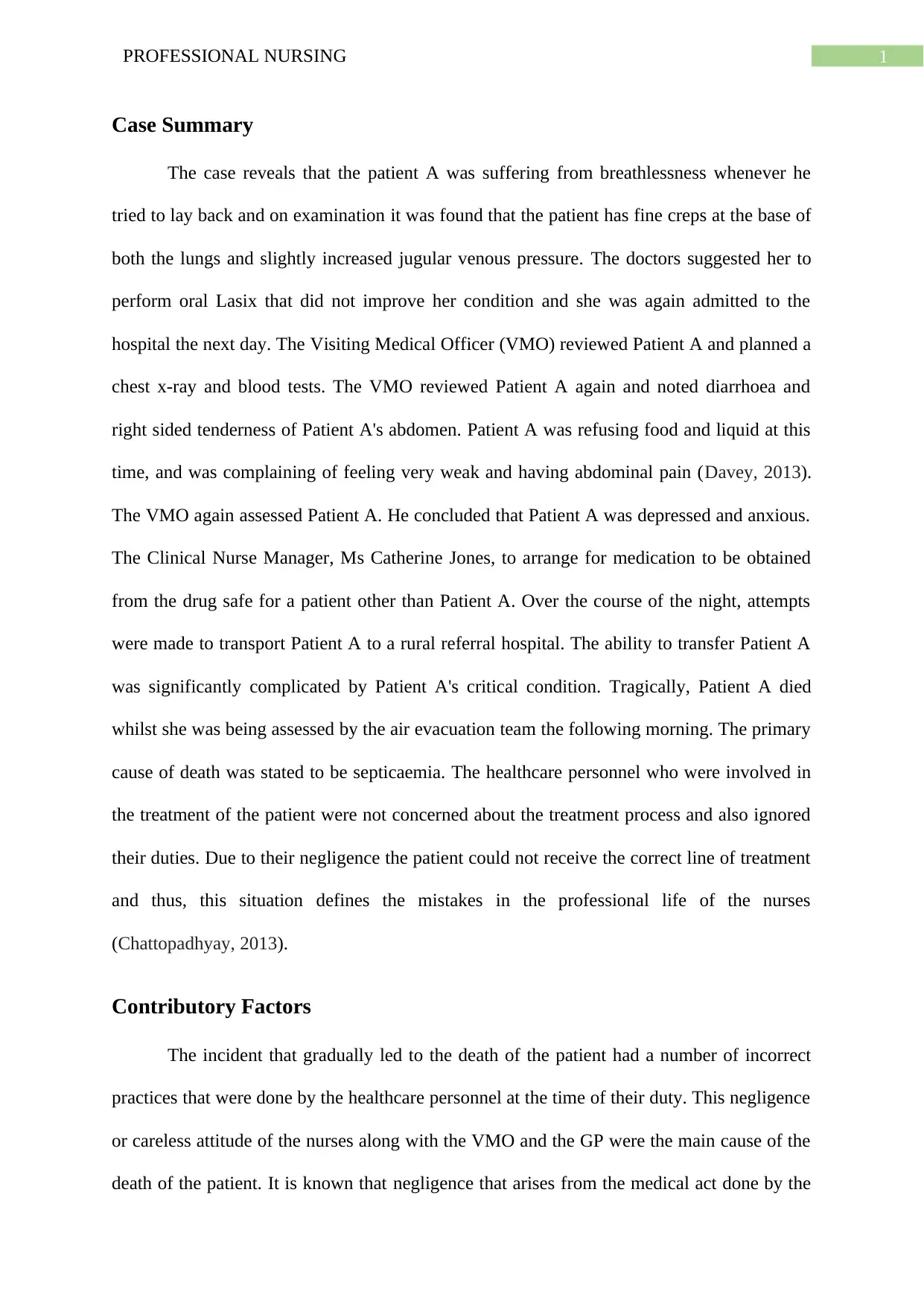
1PROFESSIONAL NURSING
Case Summary
The case reveals that the patient A was suffering from breathlessness whenever he
tried to lay back and on examination it was found that the patient has fine creps at the base of
both the lungs and slightly increased jugular venous pressure. The doctors suggested her to
perform oral Lasix that did not improve her condition and she was again admitted to the
hospital the next day. The Visiting Medical Officer (VMO) reviewed Patient A and planned a
chest x-ray and blood tests. The VMO reviewed Patient A again and noted diarrhoea and
right sided tenderness of Patient A's abdomen. Patient A was refusing food and liquid at this
time, and was complaining of feeling very weak and having abdominal pain (Davey, 2013).
The VMO again assessed Patient A. He concluded that Patient A was depressed and anxious.
The Clinical Nurse Manager, Ms Catherine Jones, to arrange for medication to be obtained
from the drug safe for a patient other than Patient A. Over the course of the night, attempts
were made to transport Patient A to a rural referral hospital. The ability to transfer Patient A
was significantly complicated by Patient A's critical condition. Tragically, Patient A died
whilst she was being assessed by the air evacuation team the following morning. The primary
cause of death was stated to be septicaemia. The healthcare personnel who were involved in
the treatment of the patient were not concerned about the treatment process and also ignored
their duties. Due to their negligence the patient could not receive the correct line of treatment
and thus, this situation defines the mistakes in the professional life of the nurses
(Chattopadhyay, 2013).
Contributory Factors
The incident that gradually led to the death of the patient had a number of incorrect
practices that were done by the healthcare personnel at the time of their duty. This negligence
or careless attitude of the nurses along with the VMO and the GP were the main cause of the
death of the patient. It is known that negligence that arises from the medical act done by the
Case Summary
The case reveals that the patient A was suffering from breathlessness whenever he
tried to lay back and on examination it was found that the patient has fine creps at the base of
both the lungs and slightly increased jugular venous pressure. The doctors suggested her to
perform oral Lasix that did not improve her condition and she was again admitted to the
hospital the next day. The Visiting Medical Officer (VMO) reviewed Patient A and planned a
chest x-ray and blood tests. The VMO reviewed Patient A again and noted diarrhoea and
right sided tenderness of Patient A's abdomen. Patient A was refusing food and liquid at this
time, and was complaining of feeling very weak and having abdominal pain (Davey, 2013).
The VMO again assessed Patient A. He concluded that Patient A was depressed and anxious.
The Clinical Nurse Manager, Ms Catherine Jones, to arrange for medication to be obtained
from the drug safe for a patient other than Patient A. Over the course of the night, attempts
were made to transport Patient A to a rural referral hospital. The ability to transfer Patient A
was significantly complicated by Patient A's critical condition. Tragically, Patient A died
whilst she was being assessed by the air evacuation team the following morning. The primary
cause of death was stated to be septicaemia. The healthcare personnel who were involved in
the treatment of the patient were not concerned about the treatment process and also ignored
their duties. Due to their negligence the patient could not receive the correct line of treatment
and thus, this situation defines the mistakes in the professional life of the nurses
(Chattopadhyay, 2013).
Contributory Factors
The incident that gradually led to the death of the patient had a number of incorrect
practices that were done by the healthcare personnel at the time of their duty. This negligence
or careless attitude of the nurses along with the VMO and the GP were the main cause of the
death of the patient. It is known that negligence that arises from the medical act done by the
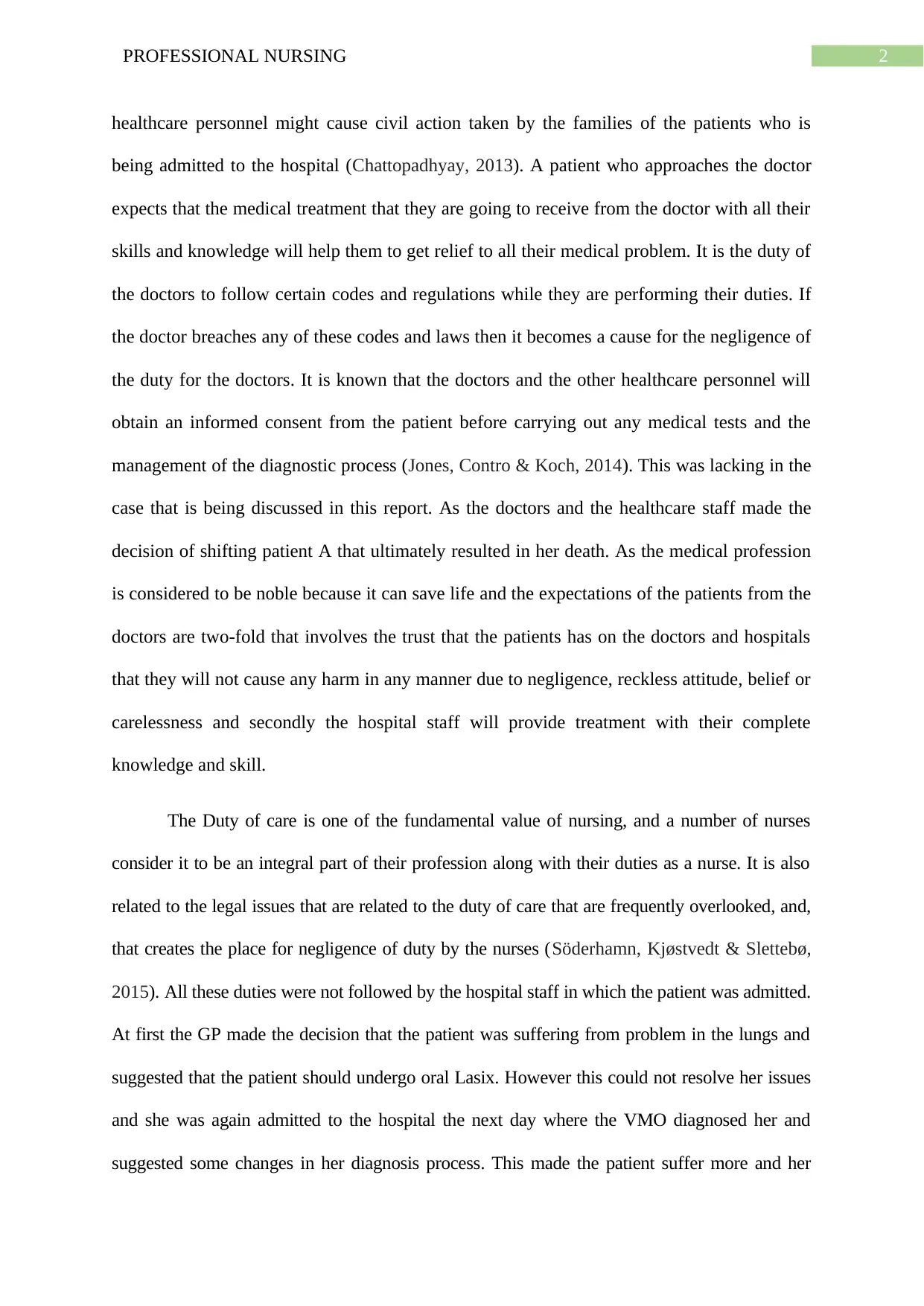
2PROFESSIONAL NURSING
healthcare personnel might cause civil action taken by the families of the patients who is
being admitted to the hospital (Chattopadhyay, 2013). A patient who approaches the doctor
expects that the medical treatment that they are going to receive from the doctor with all their
skills and knowledge will help them to get relief to all their medical problem. It is the duty of
the doctors to follow certain codes and regulations while they are performing their duties. If
the doctor breaches any of these codes and laws then it becomes a cause for the negligence of
the duty for the doctors. It is known that the doctors and the other healthcare personnel will
obtain an informed consent from the patient before carrying out any medical tests and the
management of the diagnostic process (Jones, Contro & Koch, 2014). This was lacking in the
case that is being discussed in this report. As the doctors and the healthcare staff made the
decision of shifting patient A that ultimately resulted in her death. As the medical profession
is considered to be noble because it can save life and the expectations of the patients from the
doctors are two-fold that involves the trust that the patients has on the doctors and hospitals
that they will not cause any harm in any manner due to negligence, reckless attitude, belief or
carelessness and secondly the hospital staff will provide treatment with their complete
knowledge and skill.
The Duty of care is one of the fundamental value of nursing, and a number of nurses
consider it to be an integral part of their profession along with their duties as a nurse. It is also
related to the legal issues that are related to the duty of care that are frequently overlooked, and,
that creates the place for negligence of duty by the nurses (Söderhamn, Kjøstvedt & Slettebø,
2015). All these duties were not followed by the hospital staff in which the patient was admitted.
At first the GP made the decision that the patient was suffering from problem in the lungs and
suggested that the patient should undergo oral Lasix. However this could not resolve her issues
and she was again admitted to the hospital the next day where the VMO diagnosed her and
suggested some changes in her diagnosis process. This made the patient suffer more and her
healthcare personnel might cause civil action taken by the families of the patients who is
being admitted to the hospital (Chattopadhyay, 2013). A patient who approaches the doctor
expects that the medical treatment that they are going to receive from the doctor with all their
skills and knowledge will help them to get relief to all their medical problem. It is the duty of
the doctors to follow certain codes and regulations while they are performing their duties. If
the doctor breaches any of these codes and laws then it becomes a cause for the negligence of
the duty for the doctors. It is known that the doctors and the other healthcare personnel will
obtain an informed consent from the patient before carrying out any medical tests and the
management of the diagnostic process (Jones, Contro & Koch, 2014). This was lacking in the
case that is being discussed in this report. As the doctors and the healthcare staff made the
decision of shifting patient A that ultimately resulted in her death. As the medical profession
is considered to be noble because it can save life and the expectations of the patients from the
doctors are two-fold that involves the trust that the patients has on the doctors and hospitals
that they will not cause any harm in any manner due to negligence, reckless attitude, belief or
carelessness and secondly the hospital staff will provide treatment with their complete
knowledge and skill.
The Duty of care is one of the fundamental value of nursing, and a number of nurses
consider it to be an integral part of their profession along with their duties as a nurse. It is also
related to the legal issues that are related to the duty of care that are frequently overlooked, and,
that creates the place for negligence of duty by the nurses (Söderhamn, Kjøstvedt & Slettebø,
2015). All these duties were not followed by the hospital staff in which the patient was admitted.
At first the GP made the decision that the patient was suffering from problem in the lungs and
suggested that the patient should undergo oral Lasix. However this could not resolve her issues
and she was again admitted to the hospital the next day where the VMO diagnosed her and
suggested some changes in her diagnosis process. This made the patient suffer more and her
⊘ This is a preview!⊘
Do you want full access?
Subscribe today to unlock all pages.

Trusted by 1+ million students worldwide
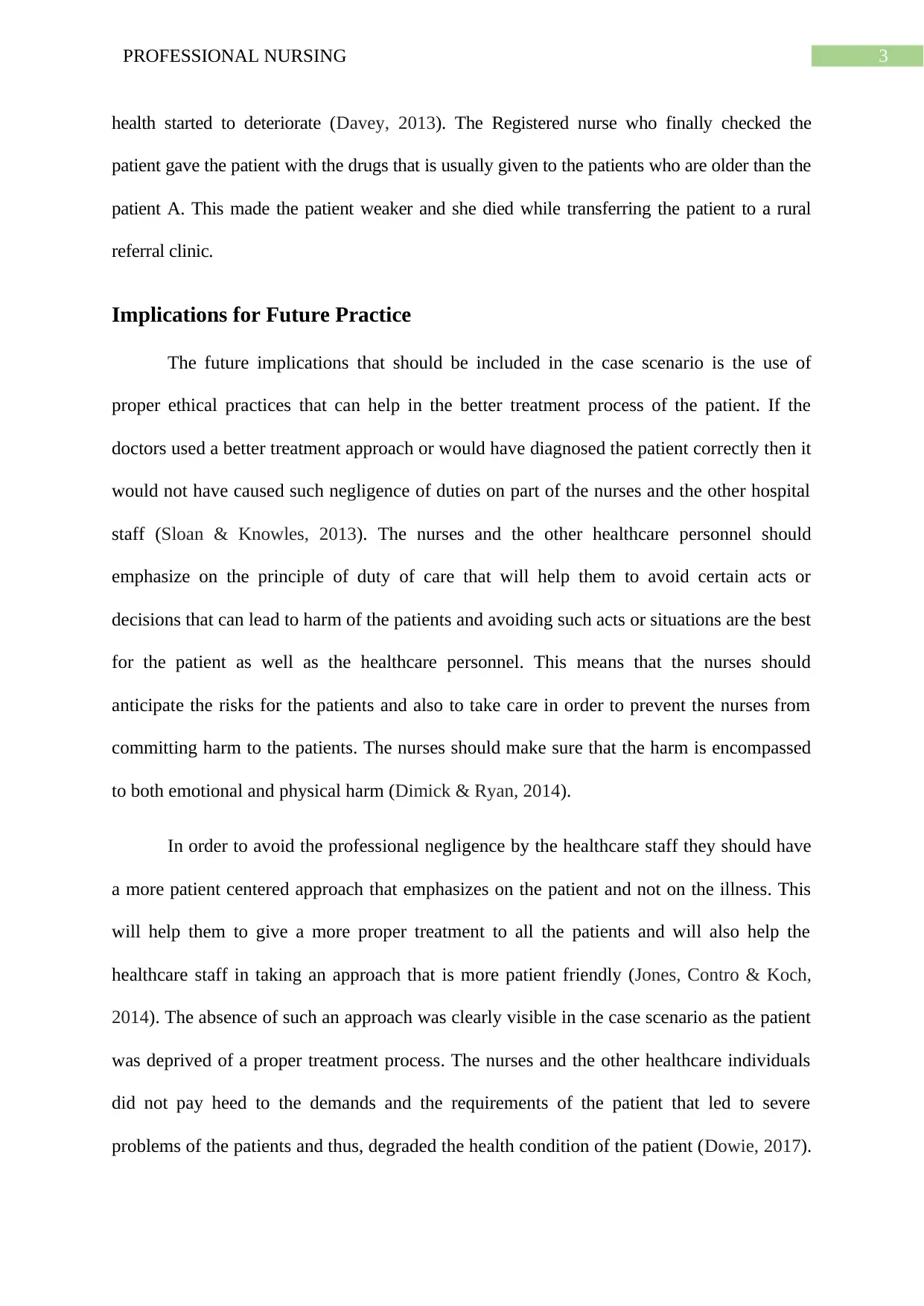
3PROFESSIONAL NURSING
health started to deteriorate (Davey, 2013). The Registered nurse who finally checked the
patient gave the patient with the drugs that is usually given to the patients who are older than the
patient A. This made the patient weaker and she died while transferring the patient to a rural
referral clinic.
Implications for Future Practice
The future implications that should be included in the case scenario is the use of
proper ethical practices that can help in the better treatment process of the patient. If the
doctors used a better treatment approach or would have diagnosed the patient correctly then it
would not have caused such negligence of duties on part of the nurses and the other hospital
staff (Sloan & Knowles, 2013). The nurses and the other healthcare personnel should
emphasize on the principle of duty of care that will help them to avoid certain acts or
decisions that can lead to harm of the patients and avoiding such acts or situations are the best
for the patient as well as the healthcare personnel. This means that the nurses should
anticipate the risks for the patients and also to take care in order to prevent the nurses from
committing harm to the patients. The nurses should make sure that the harm is encompassed
to both emotional and physical harm (Dimick & Ryan, 2014).
In order to avoid the professional negligence by the healthcare staff they should have
a more patient centered approach that emphasizes on the patient and not on the illness. This
will help them to give a more proper treatment to all the patients and will also help the
healthcare staff in taking an approach that is more patient friendly (Jones, Contro & Koch,
2014). The absence of such an approach was clearly visible in the case scenario as the patient
was deprived of a proper treatment process. The nurses and the other healthcare individuals
did not pay heed to the demands and the requirements of the patient that led to severe
problems of the patients and thus, degraded the health condition of the patient (Dowie, 2017).
health started to deteriorate (Davey, 2013). The Registered nurse who finally checked the
patient gave the patient with the drugs that is usually given to the patients who are older than the
patient A. This made the patient weaker and she died while transferring the patient to a rural
referral clinic.
Implications for Future Practice
The future implications that should be included in the case scenario is the use of
proper ethical practices that can help in the better treatment process of the patient. If the
doctors used a better treatment approach or would have diagnosed the patient correctly then it
would not have caused such negligence of duties on part of the nurses and the other hospital
staff (Sloan & Knowles, 2013). The nurses and the other healthcare personnel should
emphasize on the principle of duty of care that will help them to avoid certain acts or
decisions that can lead to harm of the patients and avoiding such acts or situations are the best
for the patient as well as the healthcare personnel. This means that the nurses should
anticipate the risks for the patients and also to take care in order to prevent the nurses from
committing harm to the patients. The nurses should make sure that the harm is encompassed
to both emotional and physical harm (Dimick & Ryan, 2014).
In order to avoid the professional negligence by the healthcare staff they should have
a more patient centered approach that emphasizes on the patient and not on the illness. This
will help them to give a more proper treatment to all the patients and will also help the
healthcare staff in taking an approach that is more patient friendly (Jones, Contro & Koch,
2014). The absence of such an approach was clearly visible in the case scenario as the patient
was deprived of a proper treatment process. The nurses and the other healthcare individuals
did not pay heed to the demands and the requirements of the patient that led to severe
problems of the patients and thus, degraded the health condition of the patient (Dowie, 2017).
Paraphrase This Document
Need a fresh take? Get an instant paraphrase of this document with our AI Paraphraser
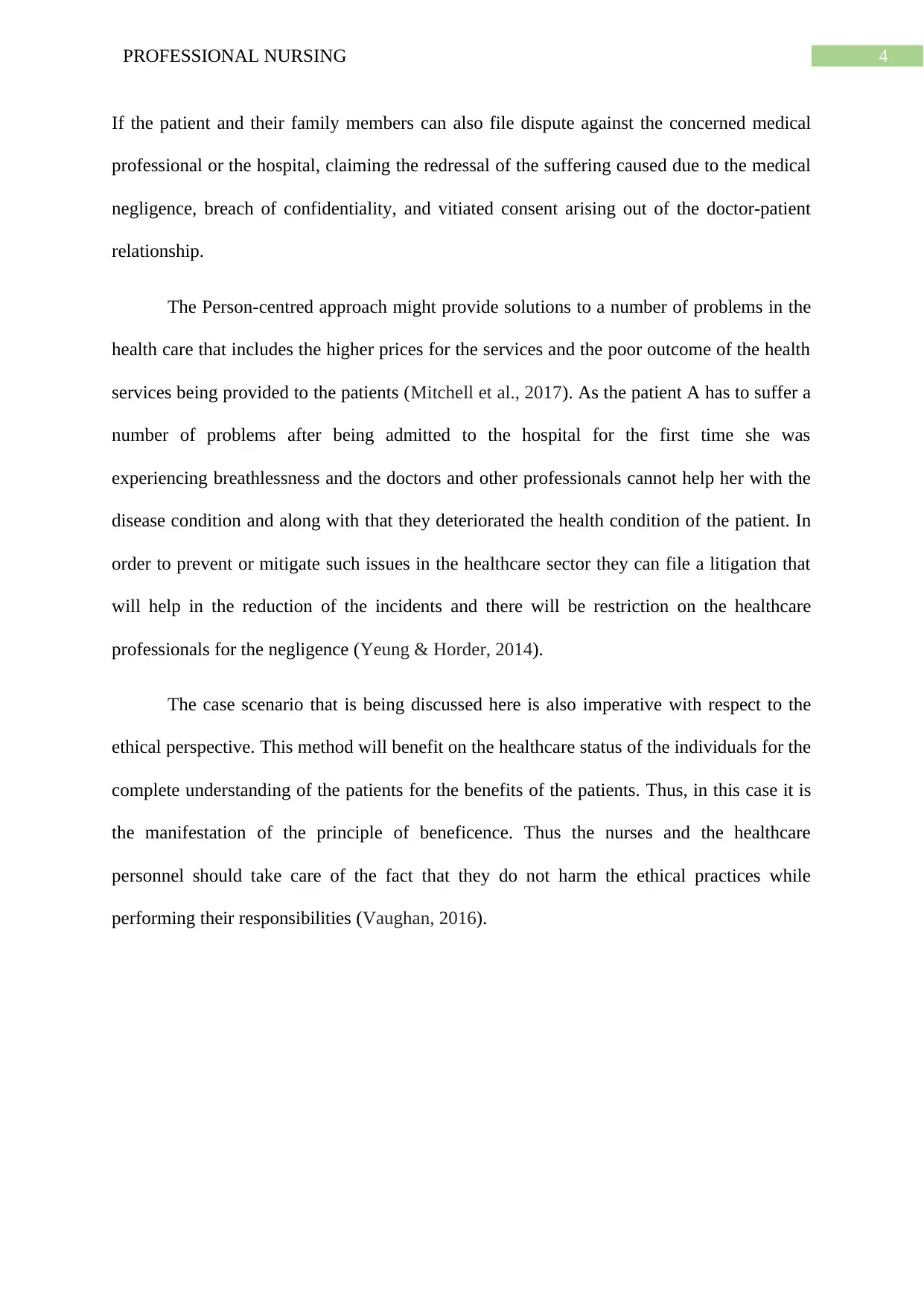
4PROFESSIONAL NURSING
If the patient and their family members can also file dispute against the concerned medical
professional or the hospital, claiming the redressal of the suffering caused due to the medical
negligence, breach of confidentiality, and vitiated consent arising out of the doctor-patient
relationship.
The Person-centred approach might provide solutions to a number of problems in the
health care that includes the higher prices for the services and the poor outcome of the health
services being provided to the patients (Mitchell et al., 2017). As the patient A has to suffer a
number of problems after being admitted to the hospital for the first time she was
experiencing breathlessness and the doctors and other professionals cannot help her with the
disease condition and along with that they deteriorated the health condition of the patient. In
order to prevent or mitigate such issues in the healthcare sector they can file a litigation that
will help in the reduction of the incidents and there will be restriction on the healthcare
professionals for the negligence (Yeung & Horder, 2014).
The case scenario that is being discussed here is also imperative with respect to the
ethical perspective. This method will benefit on the healthcare status of the individuals for the
complete understanding of the patients for the benefits of the patients. Thus, in this case it is
the manifestation of the principle of beneficence. Thus the nurses and the healthcare
personnel should take care of the fact that they do not harm the ethical practices while
performing their responsibilities (Vaughan, 2016).
If the patient and their family members can also file dispute against the concerned medical
professional or the hospital, claiming the redressal of the suffering caused due to the medical
negligence, breach of confidentiality, and vitiated consent arising out of the doctor-patient
relationship.
The Person-centred approach might provide solutions to a number of problems in the
health care that includes the higher prices for the services and the poor outcome of the health
services being provided to the patients (Mitchell et al., 2017). As the patient A has to suffer a
number of problems after being admitted to the hospital for the first time she was
experiencing breathlessness and the doctors and other professionals cannot help her with the
disease condition and along with that they deteriorated the health condition of the patient. In
order to prevent or mitigate such issues in the healthcare sector they can file a litigation that
will help in the reduction of the incidents and there will be restriction on the healthcare
professionals for the negligence (Yeung & Horder, 2014).
The case scenario that is being discussed here is also imperative with respect to the
ethical perspective. This method will benefit on the healthcare status of the individuals for the
complete understanding of the patients for the benefits of the patients. Thus, in this case it is
the manifestation of the principle of beneficence. Thus the nurses and the healthcare
personnel should take care of the fact that they do not harm the ethical practices while
performing their responsibilities (Vaughan, 2016).
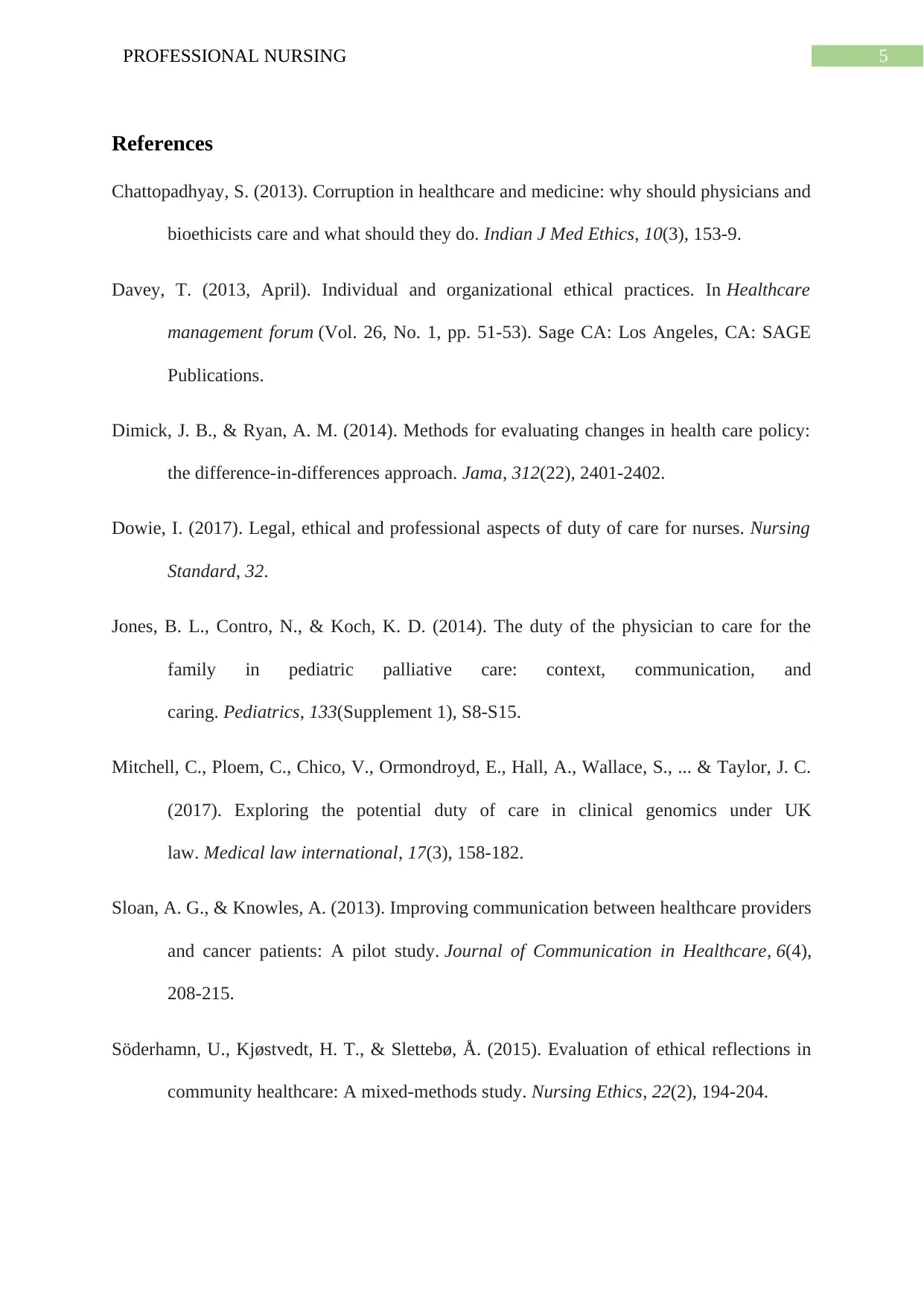
5PROFESSIONAL NURSING
References
Chattopadhyay, S. (2013). Corruption in healthcare and medicine: why should physicians and
bioethicists care and what should they do. Indian J Med Ethics, 10(3), 153-9.
Davey, T. (2013, April). Individual and organizational ethical practices. In Healthcare
management forum (Vol. 26, No. 1, pp. 51-53). Sage CA: Los Angeles, CA: SAGE
Publications.
Dimick, J. B., & Ryan, A. M. (2014). Methods for evaluating changes in health care policy:
the difference-in-differences approach. Jama, 312(22), 2401-2402.
Dowie, I. (2017). Legal, ethical and professional aspects of duty of care for nurses. Nursing
Standard, 32.
Jones, B. L., Contro, N., & Koch, K. D. (2014). The duty of the physician to care for the
family in pediatric palliative care: context, communication, and
caring. Pediatrics, 133(Supplement 1), S8-S15.
Mitchell, C., Ploem, C., Chico, V., Ormondroyd, E., Hall, A., Wallace, S., ... & Taylor, J. C.
(2017). Exploring the potential duty of care in clinical genomics under UK
law. Medical law international, 17(3), 158-182.
Sloan, A. G., & Knowles, A. (2013). Improving communication between healthcare providers
and cancer patients: A pilot study. Journal of Communication in Healthcare, 6(4),
208-215.
Söderhamn, U., Kjøstvedt, H. T., & Slettebø, Å. (2015). Evaluation of ethical reflections in
community healthcare: A mixed-methods study. Nursing Ethics, 22(2), 194-204.
References
Chattopadhyay, S. (2013). Corruption in healthcare and medicine: why should physicians and
bioethicists care and what should they do. Indian J Med Ethics, 10(3), 153-9.
Davey, T. (2013, April). Individual and organizational ethical practices. In Healthcare
management forum (Vol. 26, No. 1, pp. 51-53). Sage CA: Los Angeles, CA: SAGE
Publications.
Dimick, J. B., & Ryan, A. M. (2014). Methods for evaluating changes in health care policy:
the difference-in-differences approach. Jama, 312(22), 2401-2402.
Dowie, I. (2017). Legal, ethical and professional aspects of duty of care for nurses. Nursing
Standard, 32.
Jones, B. L., Contro, N., & Koch, K. D. (2014). The duty of the physician to care for the
family in pediatric palliative care: context, communication, and
caring. Pediatrics, 133(Supplement 1), S8-S15.
Mitchell, C., Ploem, C., Chico, V., Ormondroyd, E., Hall, A., Wallace, S., ... & Taylor, J. C.
(2017). Exploring the potential duty of care in clinical genomics under UK
law. Medical law international, 17(3), 158-182.
Sloan, A. G., & Knowles, A. (2013). Improving communication between healthcare providers
and cancer patients: A pilot study. Journal of Communication in Healthcare, 6(4),
208-215.
Söderhamn, U., Kjøstvedt, H. T., & Slettebø, Å. (2015). Evaluation of ethical reflections in
community healthcare: A mixed-methods study. Nursing Ethics, 22(2), 194-204.
⊘ This is a preview!⊘
Do you want full access?
Subscribe today to unlock all pages.

Trusted by 1+ million students worldwide
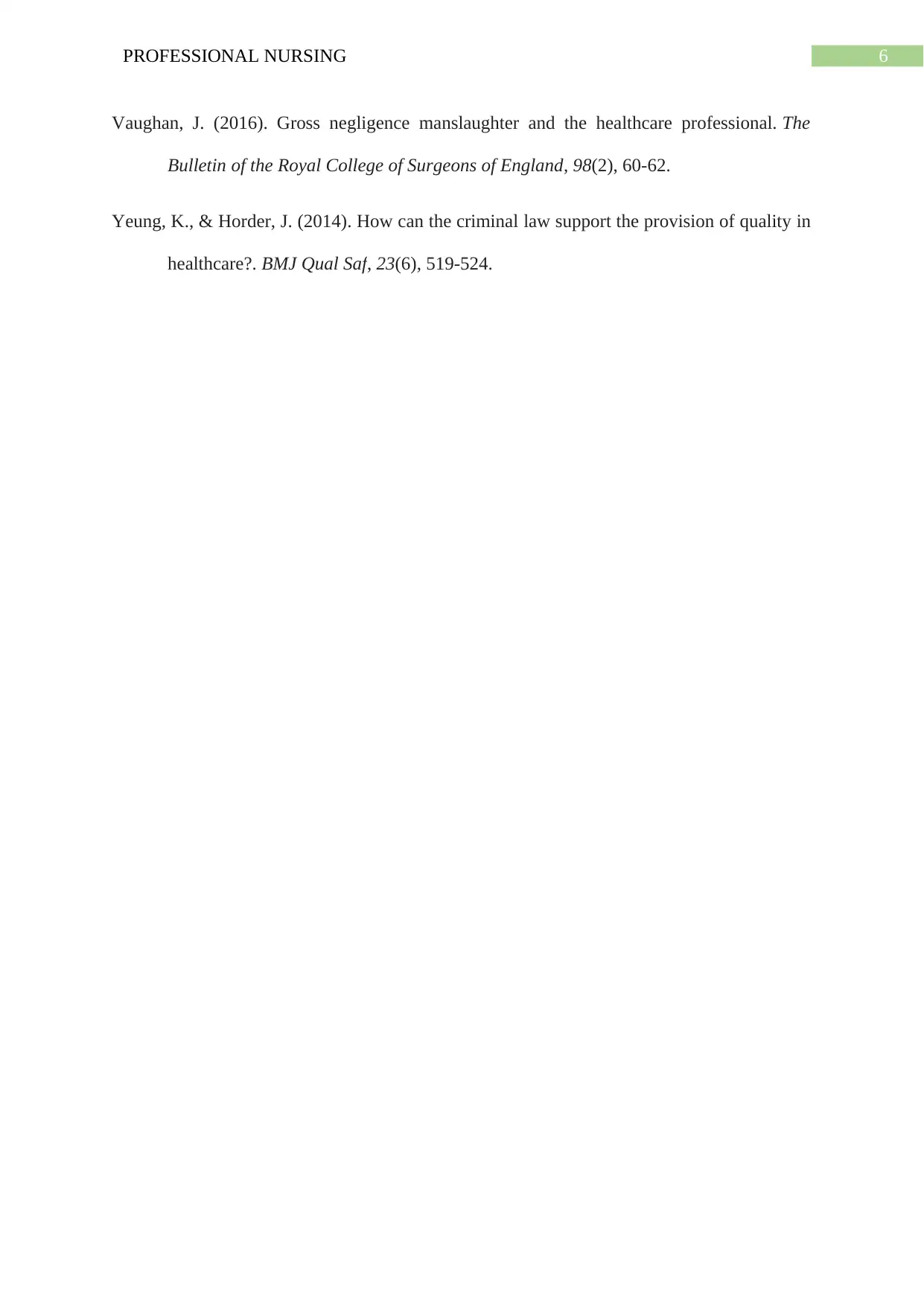
6PROFESSIONAL NURSING
Vaughan, J. (2016). Gross negligence manslaughter and the healthcare professional. The
Bulletin of the Royal College of Surgeons of England, 98(2), 60-62.
Yeung, K., & Horder, J. (2014). How can the criminal law support the provision of quality in
healthcare?. BMJ Qual Saf, 23(6), 519-524.
Vaughan, J. (2016). Gross negligence manslaughter and the healthcare professional. The
Bulletin of the Royal College of Surgeons of England, 98(2), 60-62.
Yeung, K., & Horder, J. (2014). How can the criminal law support the provision of quality in
healthcare?. BMJ Qual Saf, 23(6), 519-524.
1 out of 7
Related Documents
Your All-in-One AI-Powered Toolkit for Academic Success.
+13062052269
info@desklib.com
Available 24*7 on WhatsApp / Email
![[object Object]](/_next/static/media/star-bottom.7253800d.svg)
Unlock your academic potential
Copyright © 2020–2025 A2Z Services. All Rights Reserved. Developed and managed by ZUCOL.





